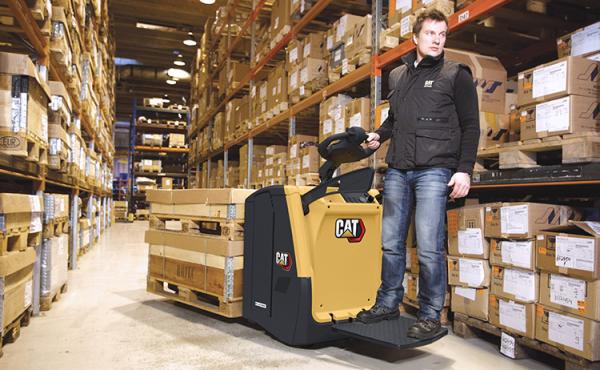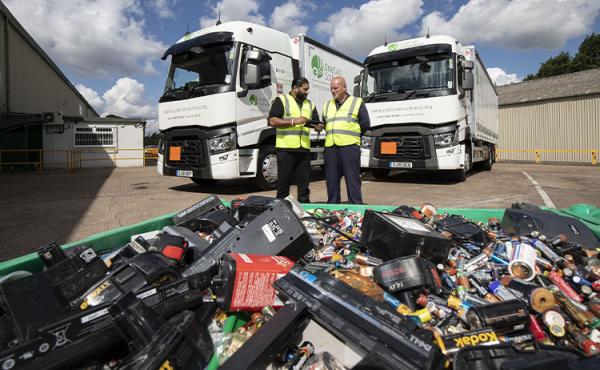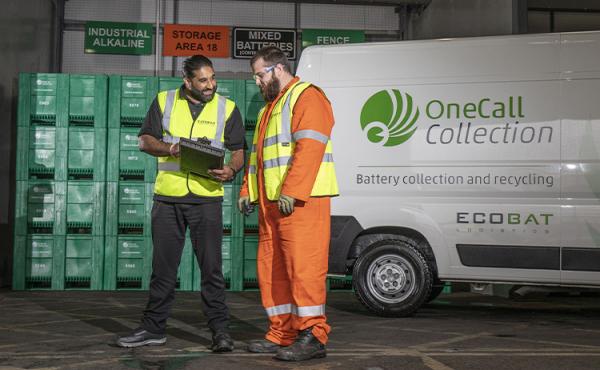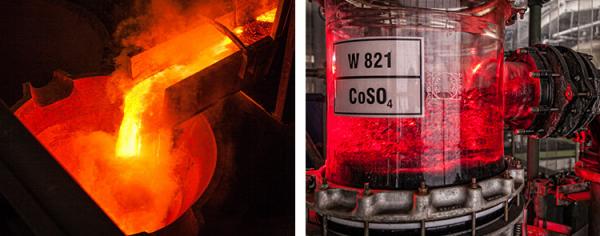What happens to used forklift batteries?
Difficulty in lithium-ion (Li-ion) battery recycling is sometimes put forward as an objection to these batteries, but should that put you off buying? For advice on this, Mark Nicholson turns to some companies handling various stages of the battery lifecycle.
Writing for Eureka, the online magazine for the materials handling professional, Mark discusses the challenges around storing, collecting, and transporting end-of-life Li-ion batteries with a company heavily involved in those activities, talks to a big European recycling business about the process of recovering materials from Li-ion cells and finds out how one Li-ion battery manufacturer is designing extra safety and recyclability into its products.
No need to worry
The global ECOBAT Technologies group is, amongst other things, the world’s largest lead producer and a major distributor of lead-acid, Li-ion and other battery types.
Tom Seward is UK Commercial Director for the ECOBAT Logistics division, whose Europe-wide OneCallCollection (OCC) service handles waste batteries of all chemistries. He said:
“As a group, we have no bias when it comes to promoting different battery technologies, Li-ion and lead-acid each have their place, and the important thing is to choose the right one for each specific application. In making that decision, you need not worry about recyclability.”
He explains: “The EU Battery Directive demands that all batteries should ultimately be recycled. Furthermore, it imposes a responsibility on the battery manufacturer to make sure this happens. In the case of used Li-ion batteries, users may have to pay for the logistics of battery collection, but the legislation is based on producer responsibility for recycling."
“Although at present there is a backlog of waste Li-ion batteries awaiting recycling, this is a temporary situation which the market will correct. As the demand for Lithium-ion battery recycling grows, the number and capacity of recyclers will continue growing to meet it.”
Hot to handle
Automotive batteries make up a significant element of the OCC workload but forklift batteries are also an important source. In addition, portable batteries are collected from local council and in-store recycling points. Despite the rapid increase in Li-ion battery use, Tom notes that its volumes are still quite small in the forklift truck market.
For used forklift Li-ion batteries, storage, collection and transport require some careful thought. While Li-ion batteries are safe when used, handled and disposed of properly, Tom warns that their safety issues are not always fully understood.
“You wouldn’t put a naked flame next to a diesel lift truck’s fuel filler hole and for battery-powered forklifts there are similarly basic rules. Importantly, there are things you can do with a lead-acid battery that would be unsafe with Li-ion.”
Similarly, there are dangers associated with lead-acid that Li-ion avoids.
He continues: “The risk with Li-ion is thermal runaway, where the battery management system loses control and a rapid chain reaction suddenly produces a huge discharge of heat which can result in a fire. It can be caused by fully discharging, overcharging, puncturing or damaging the battery, or by a defect in its manufacture.
“This potential hazard remains when an Li-ion battery is discarded, especially if it is damaged or in poor condition. Because of their volatile nature and potential for self-combustion, waste Li-ion batteries are classified as dangerous goods under the European ADR (Accord Dangereux Routier) regulations.”
ECOBAT Logistics’ OCC service begins with advice and support on these issues, including on-site evaluation of storage conditions and recommendations for improvement where necessary. To store and transport Li-ion batteries, it provides special containers whose packaging system features a fire-suppressing design. The batteries are inspected before being transported in an ADR-compliant vehicle to one of the OCC collection sites. There they are sorted by type and safely stored until an optimum quantity is ready for transfer to a recycling plant.
Battery disassembly
Lead-acid batteries are seen as being more readily recyclable than Li-ion. “They have fewer components and a relatively standardised structure which is simple to disassemble,” says Tom. “Up to 96% of their material can be recycled – including almost all of the lead. That’s a better recovery rate than in paper and glass recycling, for example.”
Lead-acid battery cases can be recycled into new polypropylene products, while the sulphuric acid electrolyte is converted into gypsum (calcium sulphate dihydrate) which is used as a soil conditioner and in plaster-based construction materials. The lead alone gives these batteries a positive value, which more than pays for their recycling. By contrast, the cost of Li-ion battery recycling is usually greater than the value of the materials recovered.
So, can you recycle lithium-ion batteries? The relative complexity and variety of Li-ion battery designs and structures means that recycling is not always straightforward. In addition, the bonding methods used to hold some of them together make disassembly difficult. However, as we will see later, it is possible to design Li-ion batteries with easy separation, component re-use and material recyclability in mind.
The Lithium-ion battery recycling process
Nickelhütte Aue GmbH (NHA), based in Germany, is one of the biggest recyclers in Europe. It receives electric vehicle batteries from all of the large automotive companies, along with growing numbers of forklift batteries from the forklift truck industry.
“We have nearly 400 years of experience as a pyrometallurgical works and recycling company,” notes Patrick Renner, NHA’s Area Manager for North and West Europe.
“We are global specialists in recycling of waste materials containing nickel, copper, cobalt, vanadium, molybdenum and tungsten. These come to us in catalysts and sludges from the chemical, petrochemical and electroplating industries, and as recyclable outputs of the hydrogenation process of oils, fats and other substances. We have been recovering metals from Li-ion batteries since 2011.”
The latest full-year figure (2019) for overall Li-ion battery recycling efficiency at NHA is 74.5%. It should be noted that this is an average and that some Li-ion batteries yield higher reclamation rates. “The main re-usable metals extracted are nickel, cobalt, copper, aluminium and iron,” says Patrick. “These are present in low amounts, so to cover our costs we have to charge battery manufacturers a recycling fee. At the moment, recovery of lithium is not economic – but it should be noted that this makes up only about 2% of a battery’s weight. We have increased our capacity over the years to meet increasing needs for Li-ion battery recycling and we are prepared for increases in future demand.”
NHA’s Lithium-ion battery recycling processes are based on pyrometallurgical treatment followed by a hydrometallurgical step. In pyrometallurgical treatment, which takes place in the core of the plant, materials are smelted in a high-temperature furnace. This results in an intermediate product containing concentrated metals. In the hydrometallurgical step, the intermediate product is leached under pressure to produce nickel sulphate, copper sulphate and cobalt sulphate by means of solvent extraction.
“With the aim of ensuring there are no waste compounds left at the end of our recycling process, we use heat from the waste gas to generate steam and electrical power for our operations,” Patrick adds. “Nickelhütte Aue is always looking for improvements to meet the challenges of the market. Our most recent environmentally friendly development is a special burner using renewable fuels such as high-caloric wastes from vegetable oil production.”
Advances in safety
Triathlon Battery Solutions is a leading global developer and manufacturer of both lead-acid and Li-ion batteries, so again we can expect an unbiased view. Triathlon’s success in addressing safe transport and recyclability issues owes much to its modular approach to Li-ion battery design, maintenance and recycling.
Ralf Kölzer, Key Account Manager at Triathlon Batterien GmbH in Germany, outlines the relevant principles.
“We build our batteries inside a strong, thick, metal ‘tray’. This box structure contains and protects the energy modules and other components. The modules, containing Li-ion cells, are each enclosed by a sturdy protective casing made from aluminium. Our cells have been benchmarked by the automotive industry, which subjects them to rigorous and very expensive testing to give confidence in their reliability and safety. We pack modules tightly into the tray, along with additional weights, and strap everything firmly into place to avoid movement during transport or use. With such a stable and armoured construction, damage-related risks are minimal.”
For forklift trucks, Triathlon produces modules in 24, 36 and 40V sizes. Modules can be combined in a tray to create larger forklift batteries, up to 80V. In the event of a fault, the individual module affected can be exchanged within the user’s country. This reduces the need for international movement of forklift batteries, along with the extra precautions such transport may require.
Ralf stresses that a non-functional module is not necessarily a dangerous one. “A cracked sensor or a broken connection, for example, would pose no danger. The Triathlon battery’s central control unit (CCU), whose data is accessible remotely, can pinpoint many different errors. Unless the module is punctured, dented or severely damaged in some other way, United Nations transport standards UN 38.3 do not classify it as hazardous. We always use ADR-compliant packaging for transporting our modules. More specifically, we follow ADR instruction P903, for all cells and batteries, and P911, for damaged or defective Li-ion cells and batteries – which must only be transported by an authorised party.”
Advances in recyclability
If a faulty module can be repaired, it will be returned to the customer. The modular configuration of Triathlon batteries also gives scope for adapting to changes in the customer’s fleet.
“If a customer buys a new generation of forklift trucks which require a different size and shape of tray, or a different battery capacity, we can rearrange the existing modules to meet those needs,”
says Ralf.
After a long service life in materials handling, Triathlon’s Li-ion modules may go on to live a second or third life in another industry. The company is very keen to get its batteries back after each life so that components can be re-used.
Large Li-ion batteries offer great scope for delaying recycling – and extracting additional benefit from the resources that went into their construction – by finding alternative uses. As a battery ages, its charge-holding capacity declines. When it will no longer hold sufficient charge for efficient forklift or automotive operation, it must be replaced. It may, however, still have enough capacity for some other function. Energy storage in power grids is an obvious one. Banks of second-or third-life batteries can store electricity during times of peak generation – by renewable as well as conventional sources – and then release it later to fill gaps in supply.
“Triathlon Li-ion modules are not recycled until they are completely spent,” Ralf confirms. “When that time comes, we take them out of the battery and send them for recycling. The rest of the battery’s components can be re-used – including the tray, weights and electrical items. They are easy to take apart, as our batteries are not glued or welded together. It’s important to note that the Li-ion cells make up just 20%, or less, of the battery weight, so at least 80% of the battery’s material is re-used. Our recycling rate for the relatively small cell content is about 86% and rising.”
Lead versus lithium
So where does all this leave the lead-acid versus Li-ion debate? “Lead is not dead,” Tom Seward of ECOBAT stresses.
“Lead-acid batteries have many important advantages and in most cases, they are still the predominant choice for forklift truck users. In the right application, Li-ion has a lot to offer though. There are many factors to weigh up when choosing a forklift battery, including the much higher initial cost of Li-ion, but recyclability shouldn’t be an objection.”
Ralf Kölzer of Triathlon agrees:
“We are very happy to make and sell lead-acid as well as Li-ion batteries. For the customer, it’s a complex decision to make. In Li-ion’s favour, I would particularly highlight the very long lifespan. Li-ion also minimises the need for battery exchanges and servicing, which in the case of lead-acid can create potential for mishandling, misuse and associated dangers. At the same time, we can see good reasons for choosing lead-acid. We urge buyers not to view recycling or transport safety as problems for either battery technology. Instead, they should research all issues deeply, seek unbiased expert advice and make the best choice for their own operational needs.”
To read the unabridged version of Mark’s article in Eureka on the Lithium-ion battery recycling challenge, click here.
To find out more about the different battery options available for your materials handling equipment, click here.






